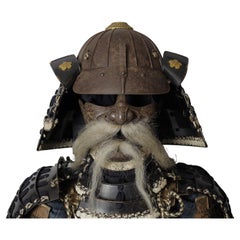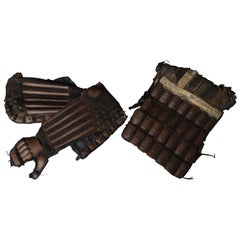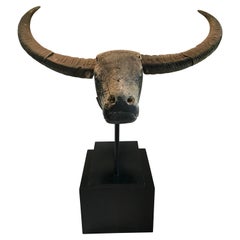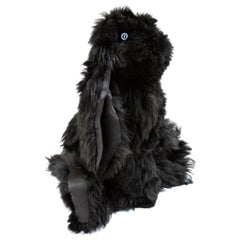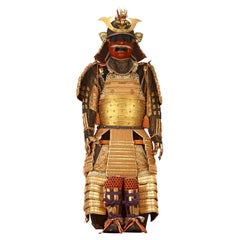Silk Arms, Armor and Weapons
8
to
3
8
8
8
6
1
1
1
13,232
290
178
120
85
6
6
6
1
1
Material: Silk
Go-Mai Uchidashi Dō Tosei Gusoku Samurai Armor Decorated with an Embossed Rabbit
Located in Milano, IT
Go-mai uchidashi do tosei gusoku
Samurai armor decorated with an embossed rabbit
Edo period, 19th century
This samurai armor is complete and original, with consistent elements...
Category
19th Century Japanese Antique Silk Arms, Armor and Weapons
Materials
Iron
Hon-kozane ni-mai do tosei gusoku
Located in Milano, IT
Hon-kozane ni-mai do tosei gusoku
Samurai armor in revival style
Edo Period, 17th to 18th century
Signature on kabuto: Jōshū jū Saotome Ietada
Kabuto [helmet]: A russet iron (tetsu sabiji) sixty-two plate kabuto, each mounted with twenty-five small tapered standing rivets (ko-boshi) of decreasing size; the front plate, larger than the others, is fitted with two lines of rivets, while the rear one is left empty, for a total of 1.550 rivets.
The typical "Saotome-byo", an extra rivet which is almost an additional signature of the Saotome armorers, is visible inside.
Maedate [helmet crest]: Kuwagata (stylized horns) with shakudo kuwagata-dai (support) fitted with three hanabishi (flower-shaped family crest) and a large gilt-wood peony
Menpō [mask]: A russet iron (tetsu sabiji) ressei-men (mask with fierce expression)
Dō [cuirass]: Ni-mai dō (made in two parts) with hon-kozane (true scale) construction. Stencilled leather plates with engraved shakudo borders, fine pierced kanamono (application) bearing a hanabishi.
Sode [shoulder guards]: Large type (ō-sode), with fine kanamono and decorations.
Kote [sleeves]: In russet iron, with a hanabishi on the back of the hand (tekko).
Haidate [thigh guard]: Of hakama type (full trousers), made of tied rectangular iron plates.
Suneate [shin guards]: Finished in black urushi lacquer.
Accessories: A saihai (commander’s baton); high-level kara-bitsu (storage box)
With its large sode (shoulder guards) and old-fashioned construction, the style of the armor is reminiscent of the medieval suits...
Category
Late 17th Century Japanese Antique Silk Arms, Armor and Weapons
Materials
Iron
18th c(Edo period) certified samurai armor (yoroi) in exceptional st. Preservati
Located in Fukuoka, JP
Elaborately made set of armor , reflecting high social status of the owner. It is appears austere and yet sophisticated with multiple gilded family crests and arabesque design on gilded copper fittings. Very fine 32 plate Kabuto helmet...
Category
Mid-18th Century Japanese Edo Antique Silk Arms, Armor and Weapons
Materials
Iron
Edo period samurai full set of armor (yoroi) with unique original helmet
Located in Fukuoka, JP
Excellent set of Samurai armor Edo period. According to the inscription on the Dou(cuirass), Armor was commissioned by a leading member of Wada Samurai family, Wada Masatada to a renown armor maker, Myochin Munetaka. 18th century. Pristine condition, with only minor abrasions and losses due to significant age. PRICE and other inquiries, please send a message. It holds prestigious Tokubetsu Kitcho Shiryo (especially important cultural item), papers by Nihon Katchū Bugu Kenkyū Hozon Kai (The Association for the Research and Preservation of Japanese Armor...
Category
Late 18th Century Japanese Edo Antique Silk Arms, Armor and Weapons
Materials
Iron
Dangae do tosei gusoku A blue-laced samurai armor with cuirass of double style
Located in Milano, IT
Dangae do tosei gusoku
A blue-laced samurai armor with cuirass of double style
Edo Period, 18th century
Kabuto [helmet]: Black lacquered eboshi-nari kabuto, in the form of this ...
Category
18th Century Antique Silk Arms, Armor and Weapons
Materials
Iron
17th-18th Century Edo Period Samurai Armor Sangu Parts, 'Haidate & Kote'
Located in Fukuoka, JP
Introducing a truly rare and remarkable item up for auction, we present the Rare Samurai Sangu armor parts, which include arms and thigh armor pieces. This extraordinary ensemble, marked with the unique identifier , originates from the mid Edo period, circa the 17th to 18th century.
While this set of armor has experienced the passage of time, it remains in fine condition, bearing witness to its historical significance. Please note that there are some rust issues present throughout, which only add to the authenticity and character of this exceptional piece. Additionally, the original silk fabric has largely deteriorated, as depicted in the accompanying photos.
Designed to fit a full adult size, this Samurai Sangu armor is a versatile addition to any historic samurai armor collection. The included arms and thigh armor pieces complete the ensemble, ensuring an immersive and comprehensive representation of traditional samurai warfare attire.
Weighing approximately 3 kilograms (6.6 pounds), this set strikes a balance between durability and mobility, allowing the wearer to move with ease while maintaining essential protection. It is essential to note that this item is sold in "as-is" condition, preserving its original state and historical integrity.
International buyers are responsible for any import duties, taxes, and charges associated with the purchase. It is recommended to consult with your country's customs office to determine the specific costs involved before placing a bid or making a purchase.
Own a rare piece of samurai history with this exceptional Rare Samurai Sangu armor set...
Category
Late 17th Century Japanese Edo Antique Silk Arms, Armor and Weapons
Materials
Iron
18th Century Hirate Clan Samurai Armor with Signed Kabuto Helmet
Located in Fukuoka, JP
This is a truly exceptional set of 18th century Samurai armor that is sure to impress any collector or enthusiast. The patinated iron used in its construction has aged beautifully, giving the armor a truly unique appearance that is sure to catch the eye. The brocade silk and cotton padding used to line the armor not only provide a comfortable fit for the wearer, but also add an extra layer of decorative flair.
One of the most striking features of this armor is the crests of the Hirate samurai clan that adorn it. These crests are a symbol of the clan's identity and heritage, and their presence on the armor speaks to the deep connection between samurai warriors and the clans they belonged to.
The Kabuto...
Category
18th Century Japanese Antique Silk Arms, Armor and Weapons
Materials
Iron
Antique Military Hat & Fitted Metal Box of Brigadier General Lawrence Drummond
Located in Hamilton, Ontario
This antique military hat and fitted hat box was made by W. Cater of London England for the Brigadier General Lawrence Drummond in approximately 1...
Category
Early 20th Century English Edwardian Silk Arms, Armor and Weapons
Materials
Metal
Related Items
Large 19th Century Indonesian Sculpture of a Bull
Located in Stockton, NJ
Massive and rare early 19th century Indonesian ship bowsprit. Originally a decoration on the front of a ship. Carved wood bull with natural horns. Museum mou...
Category
Early 19th Century Asian Antique Silk Arms, Armor and Weapons
Materials
Iron
Real Toscana Sheep Black Fur Rabbit Toy
By JG Switzer
Located in Sebastopol, CA
Design commissioned by JG SWITZER from a Ukranian plush toy artist, and sewn in our workshop from fluffy fur scraps, LITTLE JG RABBIT is for Bigs AND Littles. Created from our re-purposed, real Toscana...
Category
2010s American Arts and Crafts Silk Arms, Armor and Weapons
Materials
Fur
Exceptional 18th Century French Stone Baptismal Font
Located in Atlanta, GA
An exceptional 18th century stone Baptismal font from the South of France. Beautifully hand-sculpted with a sensational patina. Perfect as a water...
Category
18th Century French Antique Silk Arms, Armor and Weapons
Materials
Stone
17th/ 18th Century Italian Baroque Marble Holy Water Font or Stoup
Located in Buisson, FR
Beautiful Baroque marble holy water font or stoup,
Unique and original period piece. Italy, circa 1650-1750. Weathered condition.
Measures: H:10,5cm W:21,5cm D:19-26cm.
Category
17th Century Italian Baroque Antique Silk Arms, Armor and Weapons
Materials
Marble
Large English 18th Century Queen Anne Period Wooden Mortar And Pestle
Located in Haddonfield, NJ
Large English 18th Century Queen Anne Period Wooden Mortar And Pestle
Category
Late 18th Century British Folk Art Antique Silk Arms, Armor and Weapons
Materials
Wood
TOPPAI JINGASA EDO PERIOD - 18-19th Century - Japan
Located in TEYJAT, FR
This is a custom-made historical Japanese hat known as Jinggasa, worn by samurai during the Edo period (1603-1868), around the 18th to 19th century. Within the category of Jingasa, t...
Category
Late 18th Century Japanese Edo Antique Silk Arms, Armor and Weapons
Materials
Leather, Textile, Paper
Steve McCurry, Animals, Art Edition No. 1-100 ‘Chiang Mai, Thailand, 2010’
Located in Los Angeles, CA
From an elephant lovingly resting on his master’s shoulder to a dog led through the rubble of Kabul on the back of a bicycle, these images by Steve McCurry tell a thousand stories, e...
Category
21st Century and Contemporary Silk Arms, Armor and Weapons
Materials
Other
Samuraï Maeda Armor
Located in Paris, FR
Armor Samuraï Maeda, ceremonial armor
with handcrafted helmet and protects.
Made with original japanese fabrics only use for
samuraï armor confection, ...
Category
1930s Japanese Vintage Silk Arms, Armor and Weapons
Materials
Fabric, Glass
Medieval Style Armor Gauntlet Articulated Steel
Located in Rochester, NY
Articulated medieval style steel gauntlet. Well made, mid-20th century.
Category
Mid-20th Century Medieval Silk Arms, Armor and Weapons
Materials
Metal, Steel
Real Toscana Sheep Truffle Fur Rabbit Toy
By JG Switzer
Located in Sebastopol, CA
Design commissioned by JG SWITZER from a Ukranian plush toy artist, and sewn in our workshop from fluffy fur scraps, LITTLE JG RABBIT is for Bigs AND Littles. Created from our re-purposed, real Toscana...
Category
2010s American Arts and Crafts Silk Arms, Armor and Weapons
Materials
Fur
Okitenugui Kabuto Samurai Helmet Shaped as a Head Towel Saika, Early Edo Period
Located in Milano, IT
Okitenugui kabuto
Samurai helmet shaped as a head towel
Saika, early Edo period, 17th century
The Haruta armorers who moved to Kii province in the early 17th century, took the name from the village where they worked, Saika, near Wakayama, possibly on request of the local daimyo, Asano Yukinaga, a great armour amateur. Specialised in the construction of plate helmets, they produced mainly two typologies of kabuto: one with six plates covered with a chrysanthemum-shaped plate on top and one shaped as a “head towel”, called okitenugui. The latter type of kabuto employs very heavy plates crafted in a curved manner and was improved in order to make it resistant to firearms.
This okitenugui kabuto features some distinctive decorations of the Haruta school, including the application of cut-out iron elements, including eyebrows, washers and lozenge-shaped decorations on the sides. The ring on the top, however, is a rare feature and could be used to hold a small war flag.
Category
17th Century Antique Silk Arms, Armor and Weapons
Materials
Iron
Free Shipping
H 13.78 in W 15.75 in D 15.75 in
Antique Japanese Woodblock Print Book Edo Period, circa 1833
Located in Barcelona, Barcelona
Antique Japanese Oraimono book Edo period, circa 1833
Woodblock print book
Book dimensions: 260 mm x 180 mm
There are damages because it is...
Category
1830s Japanese Edo Antique Silk Arms, Armor and Weapons
Materials
Paper
Previously Available Items
Edo Period Samurai Suit
Located in New Orleans, LA
This complete nerikawa Kaga gusoku samurai suit of armor dating to the 18th century represents a stunning fusion of functional design and intric...
Category
18th Century Japanese Edo Antique Silk Arms, Armor and Weapons
Materials
Copper, Steel, Iron
Edo Period Samurai Suit Of Armor
Located in New Orleans, LA
This complete samurai okegawa dou gusoku suit of armor dating to the late 18th century is a remarkable rarity and remains in pristine condition. One of the most exceptional sets of Edo Period armor ever to grace the market, this armor would protect an esteemed warrior from head to toe.
This suit was made for a high-ranking official of the Kyogoku clan, a house of samurai in Japan. Though today the word samurai is often thought of interchangeably with warrior, it traditionally referred to a specific class of military nobility in Japan. From the late 12th century until the late 1860s when the Meiji era began, the samurai were the ruling military class, ranking directly beneath the emperor.
Esteemed Edo-period armorer Yamashiro Kuni Fujiwara Kanehisa created this extraordinary set for a noble samurai, incorporating elaborate details and opulent materials, appropriately highlighting the prestige of the armor’s owner. The set includes all of the traditional armor needed for a samurai warrior, including an elaborate helmet bearing the signature of the armorer.
The 62-plate...
Category
Late 18th Century Asian Edo Antique Silk Arms, Armor and Weapons
Materials
Copper, Iron
Maki-E Hotoke-Do Tosei Gusoku Samurai Armor Bearing the Kamon of Inaba Family
Located in Milano, IT
Maki-e hotoke-do tosei gusoku
Samurai armor bearing the kamon of Inaba family
Mid to late Edo period (1615 - 1867)
Kabuto bachi signed “Masuda Myochin Minbu Ki no Munesada Saku” and...
Category
18th Century Asian Antique Silk Arms, Armor and Weapons
Materials
Iron
Free Shipping
H 59.06 in W 39.38 in D 19.69 in
Certified Highly Graded 18th Century Yoroi, Suit of Samurai Armor
Located in Fukuoka, JP
Introducing a truly exceptional piece of history - an 18th century Samurai armor set in almost pristine state of preservation. This set is accompanied by high grade Tokubetsu-kicho-shiryo papers, issued by the Association for the Research and Preservation of Japanese Helmets...
Category
Mid-18th Century Japanese Edo Antique Silk Arms, Armor and Weapons
Materials
Iron
Free Shipping
H 19.69 in W 21.66 in D 63 in
Hon-Kozane Ni-Mai Do Tosei Gusoku
Located in Milano, IT
Hon-Kozane Ni-Mai Do Tosei Gusoku
Samurai armor bearing the kamon of the Toyama family
Edo Period, 18th century
Hand-written origami by Prof. Yamagami Hachiro (1902-1980), dated 31 March 1964.
Due to its high production cost, golden armor was infrequent during the Edo period. The hon-kozane (true scale) construction for the cuirass, the engraved gilt brass borders, and the haidate (thigh guard) decorated with a floral scroll motif painted with black lacquer over gold all indicate that this suit belonged to a samurai of a wealthy clan. The armor also features a nodowa, an additional protection for neck and throat that is exclusive to high-rank armor. The helmet is similarly of excellent quality: a 32-plate zaboshi kabuto with 13 rivets per plate and a chrysanthemum-shaped washer on each rivet.
The broad sode (shoulder guards) and fukigaeshi (helmet turns-back), the visor’s shape, the use of stenciled leather, and the plate construction of the haidate are all distinctive of revival armor, which was being produced in Japan beginning in the early eighteen century...
Category
18th Century Japanese Antique Silk Arms, Armor and Weapons
Materials
Iron
Tachi-dō Tosei Gusoku Samurai Armor with Momonari Type Helmet
Located in Milano, IT
Tachi-do Tosei gusoku
Samurai armor with momonari type helmet
Although it has not been possible to identify exactly the armor’s provenance, stylistic analysis suggests a lin...
Category
Mid-18th Century Antique Silk Arms, Armor and Weapons
Materials
Iron
Samurai Armor with Eboshi-Nari Kabuto Tachi-dō tōsei Gusoku, 17th-18th Century
Located in Milano, IT
Samurai armor with eboshi-nari kabuto
Tachi-do tosei gusoku
Early to mid Edo period (1615 - 1867)
17th-18th century
A good samurai armor of tachi-do style, made in gold ho...
Category
Late 17th Century Japanese Antique Silk Arms, Armor and Weapons
Materials
Iron
Free Shipping
H 150 in W 100 in D 60 in
Samurai Armor with “Kyu” Kamon, Mid Edo Period, 18th Century
Located in Milano, IT
Samurai Armor with “Kyu” Kamon
Mid Edo period, 18th century
Exhibition
Mei To - Katchu Ten (“Exhibition of famous swords and armor”), Izumi National History Museum, 2002
L...
Category
18th Century Japanese Antique Silk Arms, Armor and Weapons
Materials
Iron
Free Shipping
H 23.63 in W 23.63 in D 59.06 in
Dō Maru Tosei Gusoku, Japanese Armor of Do-Maru Type, Early Edo Period, 17th-18t
Located in Milano, IT
Japanese armor of Do-maru type
Early Edo period, 17th-18th century
Certificate
The armor accompanied by a certificate of registration as Koshu Tokub...
Category
Late 17th Century Japanese Edo Antique Silk Arms, Armor and Weapons
Materials
Iron
Free Shipping
H 59.06 in W 19.69 in D 19.69 in
19th Century Ottoman Banner with the Tugrah of Sultan Abdulhamid II
Located in North Hollywood, CA
19th century Ottoman silk and metal thread embroidered banner with the Tugrah of Sultan Abdulhamid II
(1876-1909).
Osmanli arma-tugra Sancagi y. 1887 Hicri 1303 II. Abdülhamid Han Sultan döneminde.
Ottoman metallic embroidered red silk banner...
Category
19th Century Turkish Islamic Antique Silk Arms, Armor and Weapons
Materials
Silk
17th Century Japanese Iron Armor Plate
Located in Chicago, IL
This iron plate would once have been part of a larger suit of armor—it dates back to Japan’s Edo Period (AD 1603—1868). Japanese families often had their own special style of armor, ...
Category
Mid-17th Century Japanese Antique Silk Arms, Armor and Weapons
Materials
Iron
Recently Viewed
View AllMore Ways To Browse
Antique Cuirass
Presentation Sword
Antique Powder Flask Powder Flasks
Antique Powder Flask
Antique Powder Flasks
Antique Halberd
Antique Scottish Sword
Antique Pole Arms
Leather Gun Case
Flintlock Pistols
Antique Signal Cannon
British Pistol
Bone Sword
Sword Cane
Cane Sword
Dagger And Sheath
Vintage Sword Blade
Ceremonial Sword



